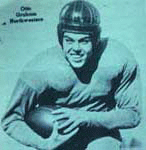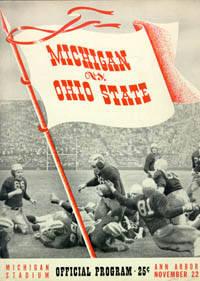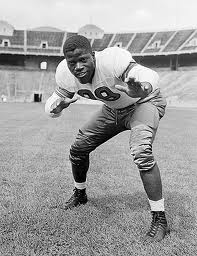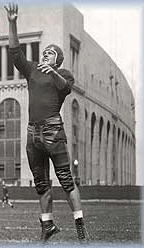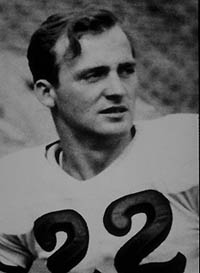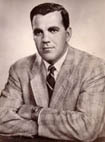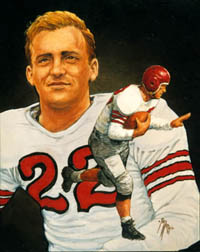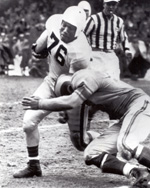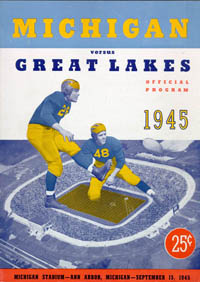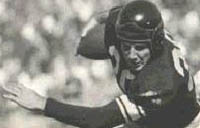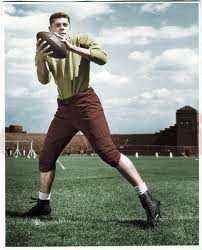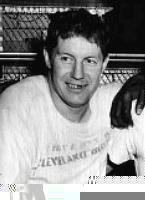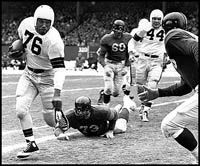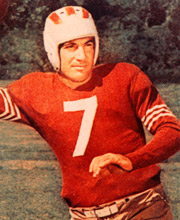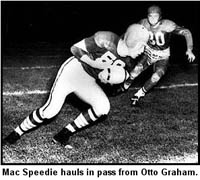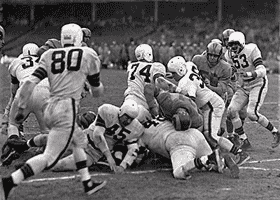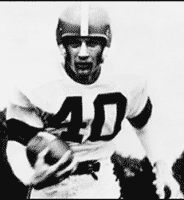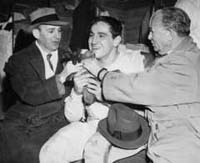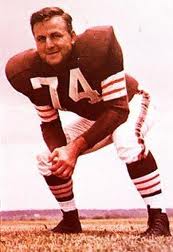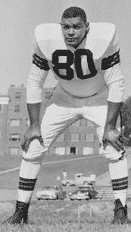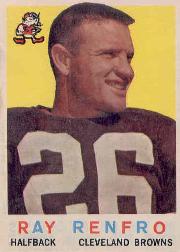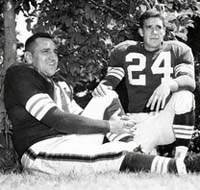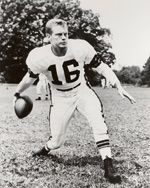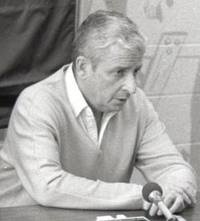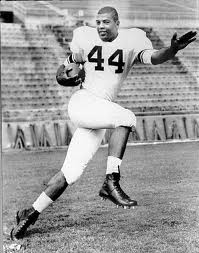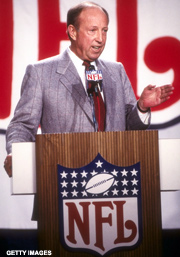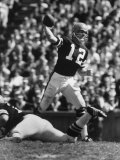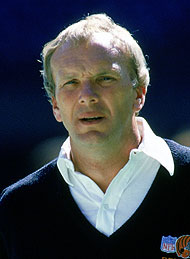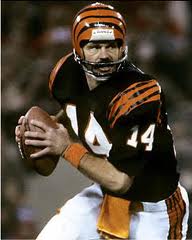Football Profiles - I | Football Profiles - III | Football Profiles - IV | Football Profiles - V
|
All these quotations are taken from the 2008 book pictured at the left which, amazingly, is the first-ever full-length biography of Paul Brown. Brown grew up in Massillon OH, a hotbed for high school football for over a century now. After playing QB for Massillon and then Miami (OH), Brown returned to his high school in 1932 as coach at the ripe age of 24. By the time he left Massillon for Ohio State in 1941, he had implemented basically all the coaching methods he would later employ in college, the military, and the pros.
|
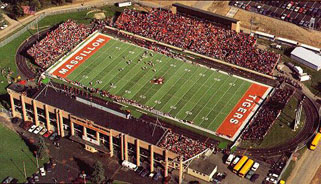

The Two Paul Brown Stadiums: (L) Massillon High School (OH), (R) Cincinnati OH
Brown's 1940 team was so awesome that, when he arranged a preseason scrimmage with the Kent State varsity, the contest was halted when Massillon reached 50 points. And Kent won its conference title that season. Brown believed his 1940 Tigers could have handled his 1941 squad at Ohio State.
|
When Fritz Crisler's Michigan Wolverines blasted the Ohio State Buckeyes in Columbus 40-0 to end the 1940 season, it was curtains for OSU Coach Francis Schmidt. Buckeye alumni and fans clamored for the "Miracle Man of Massillon," Paul Brown, as their new coach. AD Lynn St. John hired the 33-year-old wizard, who had always felt that coaching the main school in his native state to be his "ultimate dream." The rookie coach's salary? $6,500, about $1,500 more than he had made at Massillon High.
Brown brought with him six players from his 1940 Massillon Tiger team, including All-Staters Horace Gillom and Tommy James. He also persuaded two other promising Ohioans to come to Columbus: E Dante Lavelli and G Bill Willis.The new coach immediately improved the conditioning of the Buckeye team and applied his system of playbooks and tests and drills on each detail of their assignments. He also worked the freshman team hard to prepare them for their first year of eligibility the following season. It was at this time that Brown adopted the 40-yard dash as the measure of speed of a football player because he figured that's how far a player had to run to cover a punt.
Ohio State rose to #14 in the AP poll while Michigan sat nine spots higher.
UM torched the Buckeyes for 375y and punted only three times.
Alas, the OSU D couldn't hold back Westfall and company, who consumed six-and-a-half minutes on a tying drive.
As far as Ohio was concerned, the Buckeyes had won.
15 days after the Ann Arbor game, the Japanese attacked Pearl Harbor and changed everyone's future plans.
|
 Fritz Crisler
|
|
In his second year in Columbus, Brown planned to reap the benefits of his outstanding first recruiting class, who would be eligible to play varsity ball as sophomores.
The Big Ten had expanded its schedule from eight to ten games to fit in teams from military bases.
The stage was cleared for archrival Michigan, whom OSU had surprisingly tied the year before.
 Sarringhaus catches TD pass from Horvath against Michigan. For the only time since 1935, Michigan was not the final game on OSU's schedule.
Brown made sure that didn't happen.
With many returning starters, Brown could reasonably hope for an undefeated 1943 season. However, the draft and military regulations combined to decimate his squad.
|
|
Instead of the dream team he expected to have for 1943, Brown fielded an overmatched team composed of 17-year-olds and military rejects. The main causes for the decimation of his team was the lowering of the draft age from 20 to 18 and the fact that Ohio State's ROTC program was affiliated with the Army, which did not allow its cadets to play football. (The Army changed its rule for 1944 – too late to help Brown.)
As a result, the 1943 Buckeyes limped through a 3-6 season. Six defeats in one season were particularly frustrating for a coach who had lost only 12 games in his previous 13 seasons. The Top Ten of the final AP poll for the 1943 season (which did not include bowl games in that era) listed the Naval Academy (#4) plus four naval base teams. In addition, Notre Dame and Michigan, both of whom offered Naval ROTC, finished first and third respectively. The Wolverines slaughtered the outmanned Bucks 45-7 in the finale. The only OSU game from the woeful '43 season worth mentioning is the one against Illinois. The next day's headline in the Zanesville (OH) newspaper proclaimed: "Bucks Defeat Illini 12 Minutes After Final Gun." What happened?
The 35-year-old Brown was told by the military that, as a "person of prominence," he could expect to be inducted into service. So several months after the season ended, he enlisted in the navy as a lieutenant JG and was assigned to coach the football team at Great Lakes Naval Training Base near Chicago. It would be the only season in his career (outside of his first year of coaching in PA) that he would lead a team outside of Ohio. Brown inherited a team with far more experience and talent than the one he had just coached in Columbus. Great Lakes had finished 10-2 in '43, downing undefeated Notre Dame in the final game to finish sixth in the AP poll. Base commanders vied to field competitive football teams to boost morale and their own egos. When sports stars entered the service, they underwent training just like the other recruits. However, they were assigned to bases where they could contribute in their sport(s) of excellence for at least one season before being shipped overseas. Brown had to adjust his usual rules of "no drinking, no smoking, no women" to fit the older players, many of whom were competing only to delay active duty. He also had to conduct military drills and wear a sidearm like the other officers. Coaching football was not his main responsibility. His predecessor, Tony Hinkle, now served in the Pacific Theater. While the Allies had turned the tide in both Europe and the Pacific, no one knew how much longer the war would last. Before leaving for active duty, Hinkle had installed a simplified version of the Chicago Bears offense. Brown decided it was too late to change the system. He coped with the differences from what he had concocted by writing down the numbering system for plays on a sheet of paper that he referred to on the sidelines. Although the NCAA had disqualified former pro athletes from competing on service teams against colleges for the 1944 season, Brown still had more talent to work with than he had had at OSU the year before. Among his charges were DE George Young from Georgia, Ernie Plank, a DT who would star after the war at Miami (OH), and another Miami product, a HB who quickly impressed the head coach with his intelligence. His name was Ara Parseghian. Great Lakes started 4-0-1 before visiting Ohio State. The Buckeyes, revitalized by the Army's rule change, were now coached by Brown's former assistant, Carroll Widdoes. The 1942 star, Les Horvath, had returned to school to study dentistry. He would win the Heisman that year, the only time someone garnered the award after not playing the previous season. Brown later called the 26-6 loss to his former team one of his most difficult professional experiences. Great Lakes then reeled off five in a row before a 28-7 beating by Notre Dame to complete a 7-2-1 season. The team was ranked 17th in the final AP poll. Meanwhile, the Buckeyes finished 9-0 and ranked #2 behind Army's great Blanchard-Davis team. The Navy decided to keep Brown at Great Lakes for the 1945 season. However, events across the seas changed everyone's plans.
|
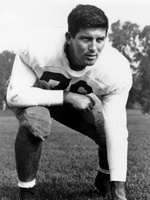 Ernie Plank
|
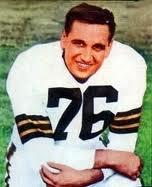 Lou Groza
|
When Paul Brown was announced as the coach of the new All-America Football Conference team in Cleveland in 1944, the owner of the Cleveland Rams of the NFL, Dan Reeves, began planning his getaway. When Reeves entered the service in 1943, he got permission from the league to suspend operations for that season. However, after a lackluster 1944 season, the Rams drafted QB Bob Waterfield out of UCLA. Waterfield was voted the league MVP in his rookie season for leading Cleveland to a 9-1 mark. In December, 1945, the Rams defeated the Washington Redskins for the championship. Only one week later, Reeves announced he was moving the team to Los Angeles.
The AAFC franchise held a contest in May 1945 to pick a name for the new team, with a $1,000 war bond for the winning suggestion. The winner was Panthers, but Brown rejected that because the name had been used for a semipro team in the 1920s. "I won't stand for anything that smacks of failure." So the team switched to the name that had actually won the contest but been rejected as too obvious – the Browns. Brown always claimed to be uncomfortable with the decision, giving the cover story that the name actually honored the Brown Bomber, heavyweight champion Joe Louis. In building his team, Brown made no secret for his predilection for Ohio players and military veterans "because they are known quantities."
Brown's squad opened its season on Friday night, September 6, 1946, at Municipal Stadium before 60,135, the largest crowd ever to see a pro football game in any league. (The previous year's Rams-Redskins championship game had attracted only 32,178 on a bitter December day). With Graham only recently discharged from the military, Brown started Cliff Lewis at QB against the Miami Seahawks, who would turn out to be a one-year embarrassment for the AAFC. The Browns routed the visitors 44-0. After a 7-0 start, the Browns lost consecutive games to the San Francisco 49ers (4-20 before another record home crowd) and to the Los Angeles Dons (17-16), who competed head-to-head with Reeves' Rams (a battle Dan would ultimately win). But Graham, who had started from the third game on while Lewis switched to S, righted the ship to defeat the 49ers in California 14-7. The Browns ended the regular season by shellacking the Brooklyn Dodgers 66-14 at Ebbets Field to win the western division with a 12-2 record and host the first AAFC championship game against the New York Yankees. The Yankees finished 10-3-1 with two of the losses to the Browns. One of those was only 7-0 in the mud in Yankee Stadium on a 33y pass from Graham to Lavelli. New York's coach, Ray Flaherty, who had won NFL titles with the Redskins, had assembled a solid team, led by TB Ace Parker, the NFL MVP for the Dodgers in 1940 who had missed both games against the Browns because of injuries. Flaherty played a large seven-man front to corral the Browns' T attack. Flaherty also enraged all of Ohio by referring to the Browns as "a team from Podunk with a high school coach." A disappointing crowd of 40,469, second smallest of the season, assembled for the December 22 title game. A snowstorm had hit the city on the 20th, and many fans who had braved the cold a year earlier for the NFC Championship Game stayed home, figuring their heroes, a two-TD favorite, could handle the visitors without them. They did, but not without a fight.
|
After winning the first All-America Football Conference title in 1946, the Cleveland Browns dominated even more the next two seasons.
The '47 Browns were pretty much the same squad that Paul Brown had assembled the year before. One exception was C and captain Jim Daniell. Just before the '46 AAFC title game, Daniell was stopped by Cleveland police and failed a sobriety test. The next day, Brown dismissed him from the team. If you're a drinker or a [woman] chaser, you'll weaken the team. We don't want you. Don't smoke in public, and if you drink in public you're fired. Ten years from now, you'll be proud to say you played on this team. Brown continued to refine his practices. Starting on Wednesday of game week, he started at 1 PM, the same time as the Sunday kickoff. Practices lasted precisely one hour and 15 minutes. Brown himself was no workaholic, sleep-in-the-office coach. "What can you accomplish when you're mentally exhausted? Some of my best thinking comes in the morning after a good rest. All my life, I got to bed at a reasonable time." He also took the team to a movie and then a good rest in a hotel the night before each game, home or away. Since he had depth in the O line, Paul instituted the system of sending in plays to Graham via "messenger Gs." In the second year of the AAFC, the Browns went 12-1-1. This put them into the championship game with the New York Yankees as in 1946. Cleveland won again 14-3. The 1948 Cleveland Indians won their first World Series since 1920. Then later that year, the Browns did them one better, not only winning their third straight AAFC championship but completing a perfect season, 14-0. The closest games were both against the San Francisco 49ers, 14-7 and 31-28. Cleveland trounced the Buffalo Bills in the championship game, 49-7. The Browns completed their sweep of the AAFC in 1949. The regular season mark was 9-1-2. Because of a change in the playoff structure, Brown's club had to win two post-season games for the championship, downing Buffalo 31-21 before dispatching the pesky 49ers 21-7. Cleveland completed its four years in the AAFC with a 47-4-3 record. Partly because the Browns had dominated the league from its inception, the AAFC didn't survive for another season. Even Cleveland became bored with the predictability of the competition. Only once did the '49 Browns draw more than 31,000 to a home game. Just 17,000 attended the playoff contest against Buffalo. And not many more turned out for the title game the next week. A few weeks earlier, the league had announced that it was folding. However, the NFL, many of its franchises damaged by direct competition from the upstart league, absorbed three AAFC franchises, the Browns, the 49ers, and the Baltimore Colts. The new teams were granted college draft picks for 1950 and the right to sign players from the defunct AAFC franchises. The NFL owners scorned Cleveland's AAFC success and openly predicted the Browns would struggle in the older league. "The worst team in our league could beat the best team in theirs," bragged Redskins owner George Marshall. Commissioner Bert Bell sent the Browns to Philadelphia against the two-time defending NFL champion Eagles to start the 1950 season. The Eagles' 20-3-1 record over the previous two seasons rivaled that of the Browns in the same period. Everyone would get a good line on how good Cleveland really was right off the bat. Philly coach Greasy Neale bragged about his squad and downplayed the opponent: "This is the best team ever put together. All the Browns do is throw the ball." However, Neale would play the season opener without his all-star RB Steve Van Buren from LSU. 71,237 fans filled Municipal Stadium on Saturday night, September 16, 1950, in anticipation of watching their Eagles prove that they were indeed the REAL champions of pro football. Instead, the Browns proved their superiority beyond a doubt, administering a 35-10 licking to the home team. Graham passed for 346y and 3 TD while the Eagles gained only 118 through the air. Philadelphia won the ground battle but only 148-141. Brown hadn't entered into the public debate but for years had put up on the locker room bulletin board any clippings downplaying his team. As a result, his Browns were more fired up than ever to show the world they were the real deal. Afterwards, Neale exclaimed, "Jeez, they've got a lotta guns, haven't they?" Bell opined, "This is the best football team I have ever seen." But there was still a long season to play. Brown knew every other team would be gunning for his boys. Two weeks later, the New York Giants spoiled Cleveland's home opener 6-0 as Graham was intercepted six times. In the rematch in New York two weeks later, the Giants prevailed again, 17-13. However, those were the only losses in Cleveland's march to a tie with the Giants in the American Division. The teams then met in a playoff at Lakefront Stadium on December 17. A snowstorm had hit two days before and the field was frozen solid. 33,000 braved the chill but left happy as Groza kicked an early and a late FG and the Browns stopped the visitors six times inside their own 10 yd line to hold on 8-3. This sent them into the title game against the Los Angeles Rams, winners of the National Division playoff over the Chicago Bears. This would be the Rams first game back in Cleveland since the 1945 season. Unfortunately, the bad weather continued and Municipal Stadium was less than half full again (29,751) the day after Christmas in 29 degrees with wind gusting to 28 mph. The offenses moved the ball amazingly well in the demanding conditions. LA led 14-13 at the half thanks to a rare missed PAT by Groza. The seesaw battled continued through the second half. LA picked up a Motley fumble and returned it six yards for a 28-20 lead. With no two-point conversion, the Browns were two scores behind heading into the final stanza. Graham hit Lavelli on a series of short passes to set up a 14-yard pass to Rex Bumgardner to close to 28-27 with 10 minutes left. The defenses prevailed until, with 3 minutes left, Graham fumbled on a QB draw and the Rams recovered at their own 25. However, the Browns D forced a punt and Cleveland took over on its own 32 with 1:15 to play. Graham then led one of the great winning drives in NFL history.
With 20 seconds left, Groza booted the winning FG. The Browns won the championship of the vaunted NFL in their first season in the league! Paul Brown had now won titles in high school, college, the AAFC, and the NFL. In all, he had coached 12 champions in 16 years. |
|
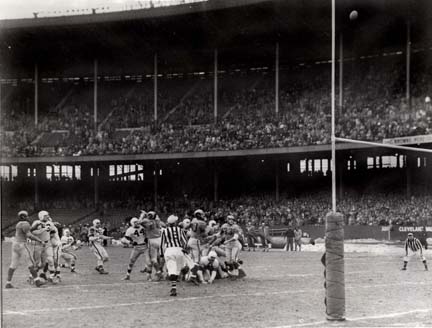
Lou Groza kicks winning FG vs Rams.
|
|
Paul Brown didn't hesitate to put his first round draft pick, Jim Brown, in the starting lineup immediately. Even though Jim wasn't too keen on blocking, Paul knew he had another Marion Motley – not quite as big but even faster. In his rookie year, 1957, Jim gained 942 yd to lead the league. JB would gain over 1,000 yd in seven of his remaining eight seasons in the league and in the one (1962) in which he missed, he amassed 996. The Browns averaged more than 50,000 fans for the first time since leaving the AAFC. With over 65,000 in Municipal Stadium for the 1957 game against the Rams, Jim broke the NFL rushing record with 237 yd and scored 4 TD in a 45-31 win. Helped by the pressure Brown's rushing took off him, journeyman QB Tommy O'Connell, who replaced Ratterman behind center, had his best season as a pro. As a result, Cleveland won the East with a 9-2-1 record. However, they were clobbered by their nemesis, the Lions, 59-14 in the championship game.
Here's how the next few years went for Paul Brown and his club.
January 25, 1961, turned out to be a significant day in Paul Brown's life. On that day, 35-year-old Art Modell and his partners bought the Browns for $4 million. As a 15% owner of the team, Brown received $500,000. At first, all seemed rosy. The new owner considered the coach/General Manager one of the chief assets he had purchased. Modell became one of the most influential owners in the league. Art had made his fortune as an advertising executive in New York. Commissioner Pete Rozelle put him to work immediately on the committee that negotiated a $4.65 million contract with CBS. Later Modell would be the leading advocate for Monday Night Football. At first awed by Paul Brown, Modell was shocked when he began to socialize with the players. Many of them couldn't stand their coach. One player who had been traded to Detroit several years earlier had remarked halfway through the following season, "I had no idea that football could be so much fun." The owner's football philosophy clashed more and more with the coach's. Modell wanted excitement and pizazz to put fans in the seats. Brown wanted to win games with his tried-and-true methods of offense and defense. Further aggravating the relationship was the fact that the other Brown, Jim, became one Modell's buddies, which allowed the star RB to push the envelope regarding Paul's strict rules. Also, Modell wanted to be kept apprised of trade negotiations and hit the ceiling when the GM traded RB-WR Bobby Mitchell to Washington for another Syracuse RB Ernie Davis. Unfortunately, in one of the saddest stories in football history, Davis contracted leukemia and died seven months later. One of Brown's assistants, Blanton Collier, became Modell's golfing buddy. Paul, who valued loyalty above all else, began to question Collier's and cut back on the responsibilities he gave him. Brown also resented the fact that players always had the ear of the owner. As the Browns limped through the 1962 season, which Paul regarded as a rebuilding year during which he restocked the team with young talent, rumors swirled that a change would be made after the season. Jim Brown has always denied that he told Modell that either the coach had to go or he would hit the road. However, he certainly wouldn't be unhappy if a change were made. Modell met with Rozelle to inform him that he intended to fire Brown. Rozelle was shocked. He knew about the estrangement between the two men, but this was the one and only Paul Brown. How do you fire the man for whom the team is named? But Modell had his mind made up. On January 7, 1963, almost two years from the day Modell purchased the team, he told Brown he was fired. The new coach would be – surprise – Blanton Collier. For the first time since he graduated from college, Paul Brown would not coach a team for the 1963 season. Many figured the record book on Paul Brown could be closed. However, at age 54, he didn't at all consider himself finished with the sport he loved. And he certainly wasn't. |
 Jim Brown
|
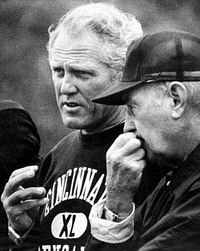 Bill Walsh and Paul Brown
|
After being fired as Browns coach after the 1963 season, Paul Brown spent five years in football limbo – although he probably considered it hell. With the title of vice president of his old team, he took charge of the college scouting. To increase his chagrin at losing his job as the only coach that Cleveland had had, the Browns began to win consistently. Collier amassed double digit wins in five of the next seven years, with nine in each of the other two seasons. The 1964 team defeated the Colts 27-0 in the championship game. Modell was exultant, with only one fly in his ointment – he never received any congratulations from Paul Brown. The next year, Collier's club lost to the Packers in the title clash.
In 1967, after the mandatory five-year waiting period, Brown was elected to the Pro Football Hall of Fame. Even if he never won another game, Brown was enshrined as a legend. But he was not finished with football. Paul joined a group of investors who paid $9 million to land an AFL franchise in Cincinnati. He would be the coach and general manager. Brown would have preferred the NFL but knew that a merger was imminent. Lo and behold, three NFL teams were transferred to the AFC: the Colts, Steelers, and Browns. So Brown's new team would play in the AFC Central along with the Browns starting in 1970. In the meantime, it was 1946 again as Paul created another new team.
As an expansion franchise, the Bengals struggled in 1968. They won two of their first three but then dropped 10 of the last 11 to finish 3-11. Desperately needing a QB, Brown drafted Greg Cook from hometown Cincinnati U. In 1969, Cook earned the AFL's Offensive Rookie of the Year, leading the league in passing. The Bengals improved slightly to 4-9-1, with one of the victories over the Super Bowl champion Kansas City Chiefs. As a result, Brown was named Coach of the Year. For the 1970 season, the Bengals moved from Cincinnati U.'s ancient Nippert Stadium to the new Riverfront Stadium. However, the expectations for the season were dashed when it was determined that Cook had torn his rotator cuff the previous season. Since the injury had been misdiagnosed and mistreated, Cook's football career was over. So Brown turned to Virgil Carter to lead his O. After playing for BYU, Carter had spent several seasons with the Bears. Since Virgil was a very accurate short passer, Brown and Walsh scrapped the long passing attack developed for Cook and drew up the first edition of what came to be known as the West Coast offense. The Bengals initiated Riverfront into the NFL with a 31-21 upset of Oakland in the first game with Sam Wyche at QB. Then they dropped six in a row, including a 30-27 defeat by the Browns in Cleveland when Carter finally assumed the reins. The Browns presented the game ball to Modell, and the fans booed Brown when he left the field without shaking hands with Collier. Paul explained that he hadn't shaken hands after games for years because of the fans on the field and said that he and Blanton had socialized before the game. Cincinnati finally ended its losing streak by belting Buffalo 43-14. The following week, 60,000, the biggest crowd in Cincy history, came to see the rematch with the upstate Browns.
The Bengals finished the 1970 season with seven straight victories for an 8-6 record. As AFC Central champs, they made the playoffs but lost @ Baltimore 17-0. The Colts went on to win the Super Bowl. At that time, it was the fastest that a new football team had made the playoffs. Brown coached Cincy for five more years.
Paul continued as team president until his death in 1991. During that time, the Bengals made the Super Bowl twice and ironically lost both times to Bill Walsh's 49ers. Those two championships by one of Brown's disciples added to the seven Super Bowls that his former players or assistants won in the 1970s. After Paul's death, the Bengals suffered 14 consecutive losing seasons. Then in 2000 Paul Brown Stadium opened in Cincinnati, the second field to be named for him. This profile ends with one of the quotes it began with. "If there is any list of great coaches that has any meaning, the name right at the top has to be Paul Brown." Bill Walsh
|
CONTENTS

